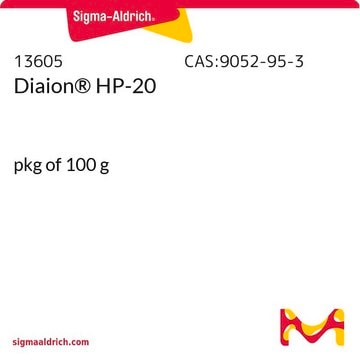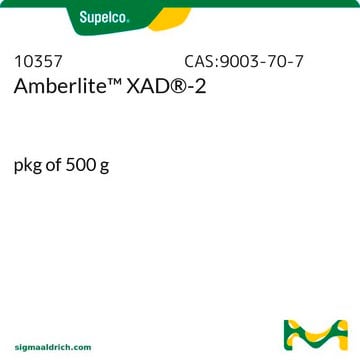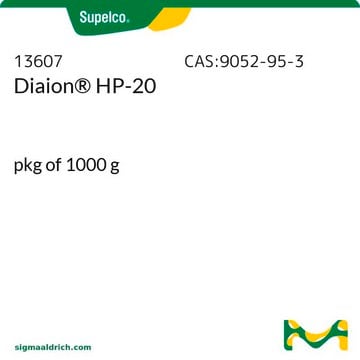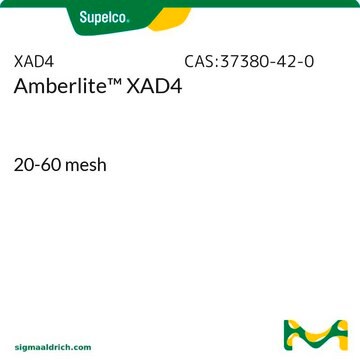If this product has an expiration or retest date, it will be shown on the Certificate of Analysis (COA, CofA). If there is no retest or expiration date listed on the product's COA, we do not have suitable stability data to determine a shelf life. For these products, the only date on the COA will be the release date; a retest, expiration, or use-by-date will not be displayed.
For all products, we recommend handling per defined conditions as printed in our product literature and website product descriptions. We recommend that products should be routinely inspected by customers to ensure they perform as expected.
For products without retest or expiration dates, our standard warranty of 1 year from the date of shipment is applicable.
For more information, please refer to the Product Dating Information document: https://www.sigmaaldrich.com/deepweb/assets/sigmaaldrich/marketing/global/documents/449/386/product-dating-information-mk.pdf
468312
Poly(styrene-co-divinylbenzene) Polymeric Adsorbent
microspheres, 1400-2500 mesh
Synonym(s):
Polystyrene crosslinked with divinylbenzene
About This Item
Recommended Products
Product Name
Poly(styrene-co-divinylbenzene), microspheres, 6.0-10.0 μm avg. part. size
form
microspheres
Quality Level
technique(s)
LPLC: suitable
thin layer chromatography (TLC): suitable
surface area
500 m2/g
matrix
Poly(styrene-co-divinylbenzene)
matrix active group
polymer
avg. part. size
6.0-10.0 μm
pore size
60 Å mean pore size
separation technique
reversed phase
SMILES string
C=Cc1ccccc1.C=Cc2ccc(C=C)cc2.C=Cc3cccc(C=C)c3.C=Cc4ccccc4C=C
InChI
1S/C10H12.C10H10.C8H8/c2*1-3-9-7-5-6-8-10(9)4-2;1-2-8-6-4-3-5-7-8/h3,5-8H,1,4H2,2H3;3-8H,1-2H2;2-7H,1H2
InChI key
NWUYHJFMYQTDRP-UHFFFAOYSA-N
Looking for similar products? Visit Product Comparison Guide
General description
Application
- in separation media for TLC, paper and LPL chromatography
- as adsorbent
- as matting agent for coatings, anti-blocking and lubrication additive for films and filler for ceramics, cosmetics and dental materials
Storage Class Code
11 - Combustible Solids
WGK
WGK 3
Flash Point(F)
Not applicable
Flash Point(C)
Not applicable
Personal Protective Equipment
Choose from one of the most recent versions:
Already Own This Product?
Find documentation for the products that you have recently purchased in the Document Library.
-
How can I determine the shelf life / expiration / retest date of this product?
1 answer-
Helpful?
-
-
How is shipping temperature determined? And how is it related to the product storage temperature?
1 answer-
Products may be shipped at a different temperature than the recommended long-term storage temperature. If the product quality is sensitive to short-term exposure to conditions other than the recommended long-term storage, it will be shipped on wet or dry-ice. If the product quality is NOT affected by short-term exposure to conditions other than the recommended long-term storage, it will be shipped at ambient temperature. As shipping routes are configured for minimum transit times, shipping at ambient temperature helps control shipping costs for our customers. For more information, please refer to the Storage and Transport Conditions document: https://www.sigmaaldrich.com/deepweb/assets/sigmaaldrich/marketing/global/documents/316/622/storage-transport-conditions-mk.pdf
Helpful?
-
-
What is the maximum mass (in Da) that can be separated using Poly(styrene-co-divinylbenzene) microspheres with an average particle size of 6.0-10.0 μm in size exclusion chromatography?
1 answer-
With an average pore diameter of 60 Å, it is estimated that the maximum mass that could be separated using this material would be 1000 Da.
Helpful?
-
-
How was surface area determined for this material?
1 answer-
The nominal "500 m2/g" surface area value for Product No. 468312 is based on supplier information, but only the average particle size is tested and reported on a batch-to-batch basis. An electrical sensing zone particle size analyzer is used for this purpose.
Helpful?
-
Active Filters
Our team of scientists has experience in all areas of research including Life Science, Material Science, Chemical Synthesis, Chromatography, Analytical and many others.
Contact Technical Service







